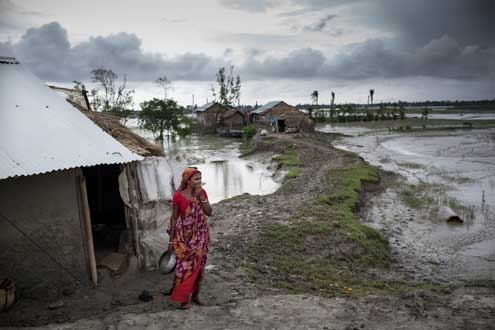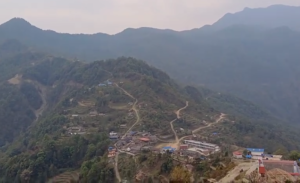Top 3 Ways Sea Level Rise Threatens Asia-Pacific Region

By Kourtnii S. Brown ————————–
On June 5, the United Nations Environment Programme (UNEP) will focus its World Environment Day campaign around “Raise Your Voice, Not the Sea Level” to draw attention to the issue of rising oceans worldwide. Sea level rise is an inevitable consequence of the overall increase in greenhouse gas (GHG) emissions and the subsequent heat trapped in the earth’s atmosphere.
The ocean remains the single largest absorber of all GHGs, as well as over 80 percent of the heat generated from global temperature increases, which is causing its volume to increase and relative height to coastal areas to rise through a process known as thermal expansion. The ocean’s atmospheric gas and heat transfers are expected to contribute to more than half of the predicted 1-3 meter sea level rise by 2100, the remaining of which will be due to additional water dumped into the oceans from rapidly melting mountain snow pack, glaciers, ice caps, ice shelves, and permafrost.
The questions now are not simply will the oceans rise, but by how much, where, and what will the effects be? The International Panel on Climate Change’s (IPCC) most conservative estimates indicate that sea level may rise on average at about 4 millimeters per year, reaching 0.22 to 0.44 meters above 1990 levels by the period 2090-2099. Nowhere is this threat as prominent as it is in Asia, especially for low-lying coastal areas in South and Southeast Asia and small island developing states in the Pacific, which are highly vulnerable to storm surges, coastal erosion, flooding, and inundation. Here are the top three ways that sea level rise will threaten this region, and the consequences if global action to reducing GHGs remains inadequate:
1 Displacement of millions of people. The IPCC’s fourth assessment report states that there are about 12 million people in 23 coastal cities across China, Japan, and Korea who make up 28 percent of the total global population living in low elevation coastal zones at risk of severe flooding from rising sea levels. In South and Southeast Asia, another 250 million poor rural people live in the low-lying river megadeltas of Bangladesh, India, Myanmar, Thailand, Cambodia, and Vietnam, of which 2 million will be directly affected by inundation from sea level rise by midcentury. The IPCC also estimates that by 2050, sea level rise in the Ganges-Brahmaputra-Meghna delta in Bangladesh could directly displace more than 3 million of the 111 million people living there, and up to 7 of the 18 million people living along the Mekong delta in Vietnam. Bangladesh could lose nearly one-quarter of the land area it had in 1989, in a worst-case scenario, displacing up to 13 million people total by 2100. Without dyke reinforcements and improved drainage, among other solutions, even conservative rise estimates along the coast of Vietnam would inundate 5.3 percent of its total land area.Furthermore, a 1-meter rise in sea level over the next century would submerge many small island nations in the South Pacific, such as the Solomon Islands, the Carteret Islands, Micronesia, Palau, Tuvalu, Kiribati, and the Maldives in the Indian Ocean, most of which are just 2 meters above mean sea level. One large storm at high tide could produce catastrophic surges and possibly threaten the very existence of these nations. The president of Kiribati, Anote Tong, is already in talks with Fiji’s government to buy up to 5,000 acres of land in order to relocate its total population of 102,697 people.
2 Loss of millions of hectares of arable land. Encroaching seawater and increased salinity in groundwater tables is causing much of the water supply and soil to become too salty to grow crops and support animal species in the Asia-Pacific. Other effects of global warming, such as variable precipitation, more frequent droughts and floods, and shrinking of the glaciers that supply freshwater to river deltas, may also worsen the impact of sea level rise. Reduced river flows and rainfall during the dry seasons, for example, will speed up the rate of saline intrusion of rivers and wetlands as encroaching seawater is able to move further upstream during these periods of low flow. During the rainy seasons, excessive water levels can lead to overly wet conditions during the harvest on arable lands and could also cause a shift in the timing of planting or harvesting crops leading to a higher demand for water during the dry season. Most deltas are also undergoing subsidence (localized sinking), caused by human activities such as groundwater extraction, dams, and river diversions, affecting the relative height of sea level as well.Arable land throughout low-lying deltas in South and Southeast Asia produces 88 percent of the world’s rice supply, much of which is slated for domestic consumption and much of which is under threat from rising oceans. Rice is a staple food in both Bangladesh and Vietnam, and three-season rice farming is vital to both economies. The United Nations Food and Agricultural Organization reports that more than 16 percent (100 million hectares) of arable land in Bangladesh and 25 percent (2.6 million hectares) in Vietnam used to grow rice will be affected by a 1-meter rise in sea level by the middle of the century, with the added pressure of rising air temperatures significantly reducing rice yields by up to 10 percent. At just half a meter rise, about 70 percent of the Mekong River Delta will be become highly vulnerable to flooding during the rainy season, where over half of Vietnam’s rice supply has been grown since 1997.
3 Billions of dollars in economic costs. The ADB published an eye-opening report in January on the “Economic Costs of Rising Sea Levels in the Asia and Pacific,” which quantifies just how costly sea level rise will be for infrastructure, industries, coastal zones, and agriculture in the region. In the 23 East Asian cities vulnerable to flooding, there is an estimated value of $864 billion in assets exposed to inundation by 2100. Over the next century, the mean economic losses from climate-induced disasters for Indonesia, the Philippines, Thailand, and Vietnam are estimated to be equivalent to losing 6.7 percent of combined GDP each year, more than twice the global average loss. At the same time, the average yearly price of adaptation measures to reduce the effects of sea level rise in the four countries would be less than 0.3 percent of GDP annually between 2010 and 2050 to protect the most vulnerable sectors. Furthermore, the ADB proposes that the annual benefits in terms of avoided damage from climate change are likely to exceed the annual economic losses after 2060. In places such as Papua New Guinea and Timor-Leste, annual GDP losses due to the effects of climate change could reach as high as 15.2 and 10 percent respectively, and under the IPCC’s worst case scenarios could cost the Pacific region $775 million (2.5 percent of GDP) per year on average to prepare for sea level rise by 2050.
If we do nothing to mitigate our heat-trapping GHG emissions, the world and the region risk facing these worst-case scenarios. But if policymakers and communities ramp up efforts to adjust to these impacts, then we can reduce the overall costs to people, land, and economies. High impact adaptation measures will be needed to strengthen flood resilience, protect people and assets, and better plan future development in order to deter massive displacement, food insecurity, and damage to infrastructure in this part of the world. The cost of adaptation to sea level rise in the Asia-Pacific would be large, but the benefits to human security would far outweigh the expense.
Kourtnii S. Brown is a program officer for The Asia Foundation’s Environment Programs in San Francisco. She can be reached at kourtnii.brown@asiafoundation.org. The views and opinions expressed here are those of the individual author and not those of The Asia Foundation.
Courtesy : Asia Foundation
June 5 , 2014














